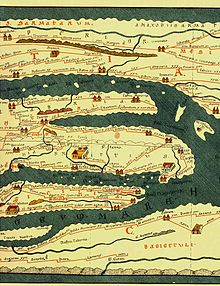Heraclea Lucania
Ἡράκλεια | |
Siris | |
| Founded | 432 BCE |
|---|---|
| Events | Battle of Heraclea |
| Site notes | |
| Condition | Ruined |
| Ownership | Public |
| Management | Soprintendenza per i Beni Archeologici della Basilicata |
| Public access | Yes |
| Website | Area archeologica di Herakleia (in Italian) |
Heraclea, also Heracleia or Herakleia (
History

It was a
The new colony appears to have risen rapidly to power and prosperity, protected by the fostering care of the Tarentines, who were at one time engaged in war with the
But beyond the general fact that it enjoyed great wealth and prosperity, advantages which it doubtless owed to the noted fertility of its territory, we have scarcely any information concerning the history of Heraclea until we reach a period when it was already beginning to decline. We cannot doubt that it took part with the Tarentines in their wars against the Messapians and

Heraclea was certainly at this time in alliance with the Tarentines and Lucanians against Rome; and it was doubtless with the view of detaching it from this alliance that the Romans were induced shortly afterwards (278 BCE) to grant to the Heracleans a treaty of alliance on such favorable terms that it is called by
The time and circumstances of its final extinction are wholly unknown, but the site is now desolate, and the whole neighbouring district, once celebrated as one of the most fertile in Italy, was by the mid-19th century almost wholly uninhabited. The position of the ancient city may nevertheless be clearly identified; and though no ruins worthy of the name are still extant, large heaps of rubbish and foundations of ancient buildings mark the site of Heraclea near Policoro, about 5 km from the sea, and a short distance from the right bank of the Aciris. Numerous coins, bronzes, and other relics of antiquity have been discovered on the spot. A medieval town, Anglona, was founded on the site; however, once a bishopric, now itself is but a heap of ruins, among which are those of an 11th-century church.
Tabulae Heracleenses
The bronze tablets commonly known as the
Art
Heraclea is generally regarded as the native country of the celebrated painter Zeuxis, though there is much doubt to which of the numerous cities of the name that distinguished artist really owed his birth. But the flourishing state of the arts in the Lucanian Heraclea (in common with most of the neighbouring cities of Magna Graecia) is attested by the beauty and variety of its coins, some of which may deservedly be reckoned among the choicest specimens of Greek art; while their number sufficiently proves the opulence and commercial activity of the city to which they belong.[14]
Gallery
-
Coins found during excavations
-
Jewelry found during excavations
-
Pottery found during the excavations
-
Pottery found during the excavations
-
Silver coin from Heraclea (390-340 BC). Obv. Head ofHerakles wrestling with the Nemean lion.
See also
Notes
- ^ Herodotus, 8.61–62.
- ^ Strabo, 6.1.14.
- ^ Strabo, 6.1.14; Diodorus, 12.36.4.
- ^ Livy, 8.24 .
- ^ Livy, 1.18 ; Pliny, iii.11.97.
- ^ a b Strabo, 6.3.4.
- ^ Livy, 8.24 ; Strabo, 6.3.4.
- Liris; and the same blunder occurs in Orosius, who says, apud Heracleam Campaniae urbem, fluviumque Lirim; for which last the editors substitute Sirim, though the mistake is evidently that of the author, and not of the copyist.
- ^ Cicero, pro Balbo, ( 22).50.
- ^ Cicero, pro Balbo (8).21.
- ^ a b Hogarth 1911.
- ^ Cicero, pro Archia (4).8.
- ^ Strabo, 6.1.14; Cicero, pro Archia (4).6, (5).10 ; Mela 2.68 ; Pliny, iii.11.97.
- Eckhel, p. 153; James Millingen, p. 111.
References
- Cicero, Marcus Tullius, The Orations of Marcus Tullius Cicero, C. D. Yonge (translator), B. A. London. George Bell & Sons, York Street, Covent Garden. 1891. 4 volumes.
- ISBN 0-674-99413-2.
- Eckhel, Joseph Hilarius, Doctrina Nummorum Veterum, Vienna, Volume 1. 1792.
- Florus, Epitome of Roman History. John Selby Watson (translator). (1889).
- .
- Livy; History of Rome, Rev. Canon Roberts (translator), Ernest Rhys (Ed.); (1905) London: J. M. Dent & Sons, Ltd.
- Mela, De situ orbis
- Millingen, J. Numismatique de l'Ancienne Italie. Florence, 1841.
- Orosius, Historiae adversum Paganos
- The Natural History (eds. John Bostock, M.D., F.R.S. H.T. Riley, Esq., B.A.) London. Taylor and Francis, Red Lion Court, Fleet Street. (1855). Online versionat the Perseus Digital Library.
- at Project Gutenberg.
- Smith, William; Dictionary of Greek and Roman Biography and Mythology: "Heracleia", London (1867)
- ISBN 0-674-99201-6.
- Zonaras, Joannes. Extracts of History.
 This article incorporates text from a publication now in the public domain: Smith, William, ed. (1854–1857). Dictionary of Greek and Roman Geography. London: John Murray.
This article incorporates text from a publication now in the public domain: Smith, William, ed. (1854–1857). Dictionary of Greek and Roman Geography. London: John Murray. {{cite encyclopedia}}: Missing or empty|title=(help)- This article incorporates text from a publication now in the public domain: Hogarth, David George (1911). "Heraclea s.v. 1. Heraclea". In Chisholm, Hugh (ed.). Encyclopædia Britannica. Vol. 13 (11th ed.). Cambridge University Press. p. 308.
External links
- Official website Archived 2016-03-03 at the Wayback Machine (in Italian)
- Museo Archeologico Nazionale della Siritide Archived 2015-02-04 at the Wayback Machine (in Italian)
- Information about the archaeological site on APT Basilicata Archived 2017-02-22 at the Wayback Machine
- Information about the Museo Archeologico Nazionale della Siritide on APT Basilicata Archived 2019-04-25 at the Wayback Machine
- Coins of Lucanian Heraclea





